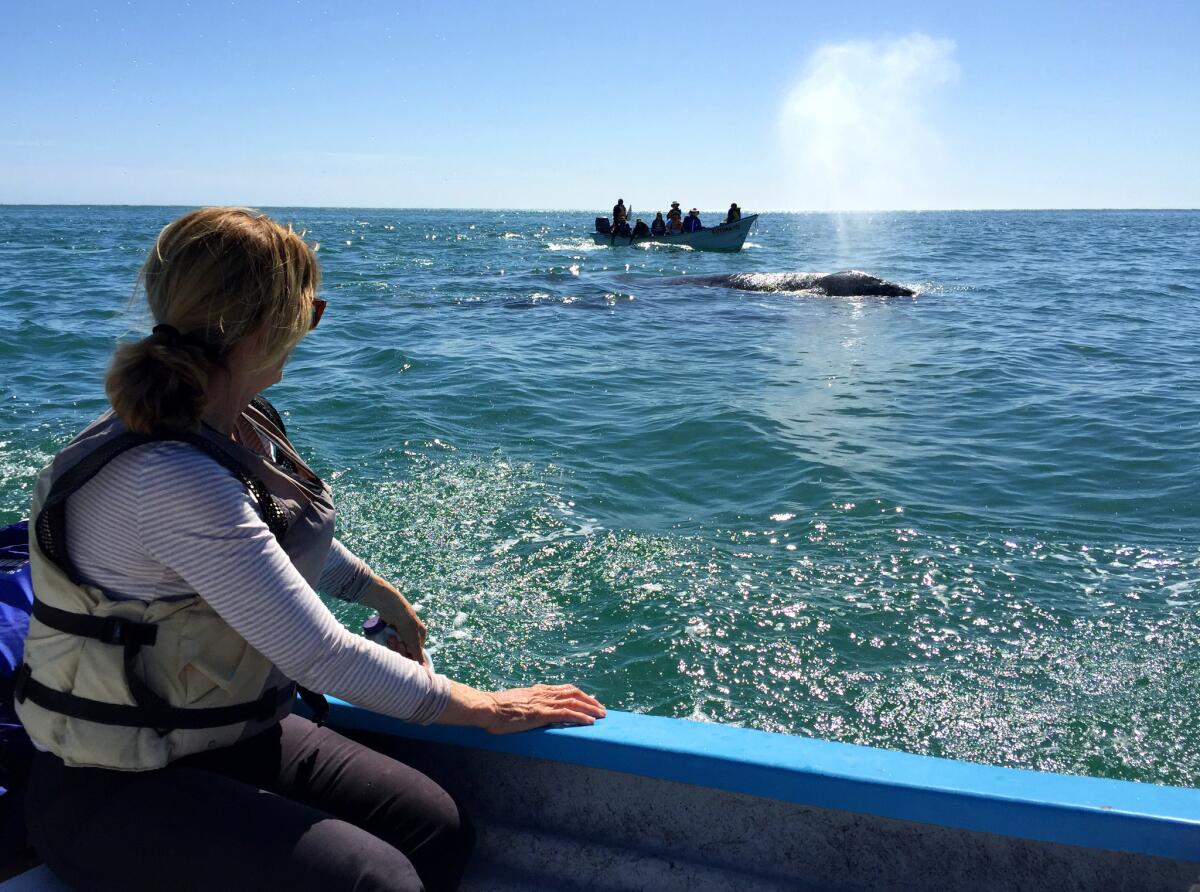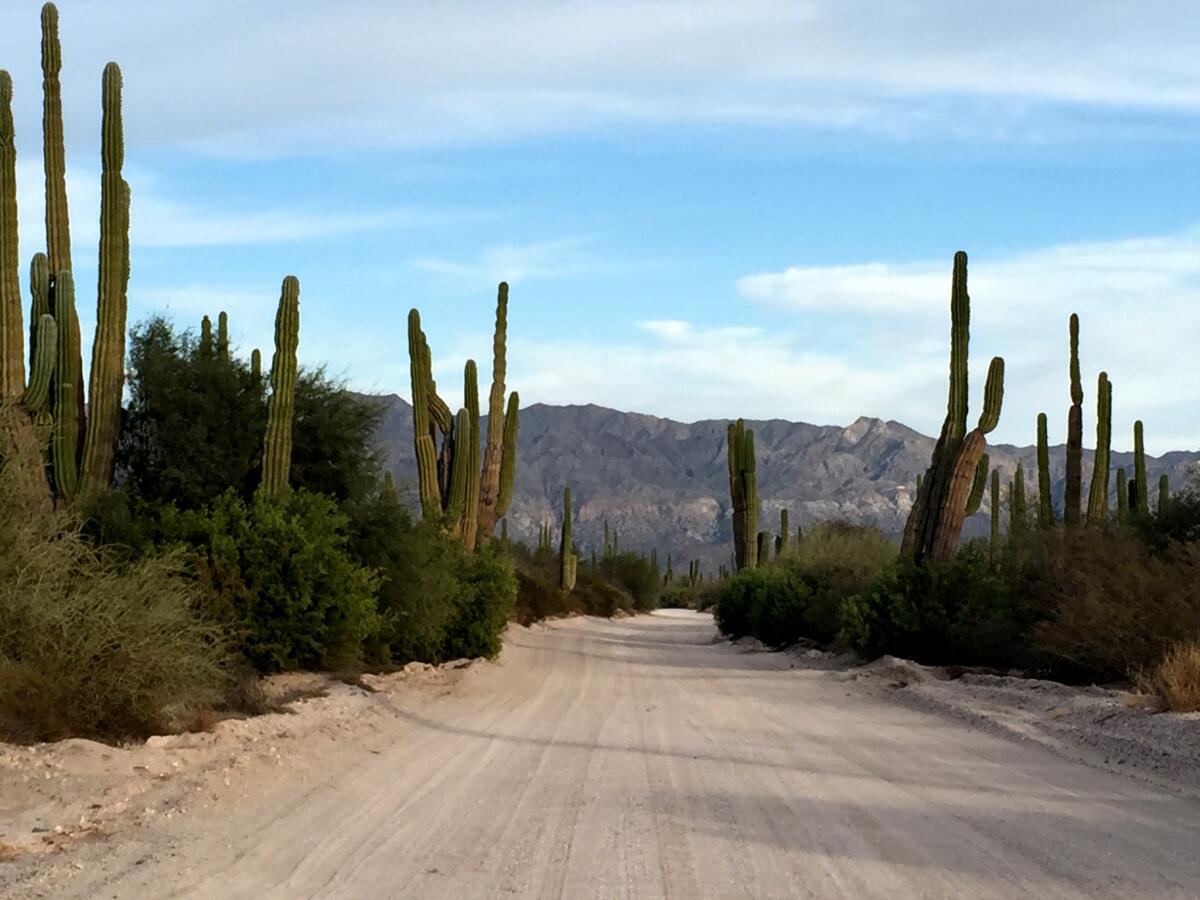In San Ignacio Lagoon, Mexico, the whales are so close you could kiss them — or at least try
Reporting from SAN IGNACIO LAGOON, Mexico — There are whale people — and then there’s the rest of the world.
Whale people don’t always signal their status, although some can be seen sporting fluke earrings or T-shirts with sayings such as “I speak whale.” If you need to find a member of the Cetacean Nation in a crowd, you need only mutter: “I’m going on a whale-watching trip where you get to watch mothers and babies frolicking nearby.”
Dissolution into a puddle of goo will follow.
I had a chance to join their ranks in March at Kuyimá Eco-Lodge, a “whale camp” at San Ignacio Lagoon, about 560 miles south of Tijuana on the Pacific side of Baja California. I emerged a convert, but I don’t think I’m going to be wearing the T-shirt.
Statement-making clothing doesn’t do justice to watching gray whales as they spy-hop (a feat that vaguely resembles treading water) and open their mouths to have their tongues scratched. It was strange — otherworldly — and, in the end, enthralling.
Star attractions
A friend proposed the trip last summer. “Are you guys interested in a serious Baja whale-watching trip? “ she asked in an email. “You get to pet baby whales three days in a row.”
We booked the three-day trip in October for seven people. The camp, which sits on a windswept beach, is part of a larger area that’s a UNESCO World Heritage site. It can accommodate 25 or so visitors at a time and is open from mid-December to the end of April.
The star attractions, of course, are the eastern North Pacific gray whales that winter in the (relatively) warm waters. Males and females without offspring typically start their journey north to Alaska in February; some mothers and babies linger a bit longer.

We saw plenty of whales on our first outing, which began about 90 minutes after arriving at the camp. We climbed into a panga, an open motorboat that carries six to eight passengers, a guide and a pangañero, and the nonstop chatter began.
“I can’t wait to kiss a baby whale” one of my traveling companions said, and almost everyone on the boat seemed to share her enthusiasm.
I didn’t quite get it.
Surely the whales didn’t get close enough for such intimate contact. Surely my boat-mates didn’t really want to let their lips touch whale skin.
They did.
Everyone leaned over the side of the panga, crooning and splashing the water in the hope that the commotion would attract “friendlies” that would swim close enough to touch. The tactic was effective, especially when it came to the babies.
The more determined observers managed to contort their bodies until they were halfway out of the boat, put their hands on either side of a calf’s head and smooch it on the snout.
All of us had read about this phenomenon, but it was still astonishing — and more than little bewildering. The grays are among the largest animals on the planet.
Were they really creatures that wanted to commune with us? And why would they?
Whale kisses
After we landed at the airport in Loreto, a town on the Gulf of California, we drove, in two rental cars, on Baja’s Highway 1 to tiny San Ignacio (about 40 miles from the Pacific Coast ), where we would spend the night at the Desert Inn San Ignacio.
After we checked in at the Ecoturismo Kuyimá office the next morning, we headed west to the lagoon. For the first 50 minutes, we drove on a paved road that carved through elephant cactus and scrub.
The cactus eventually disappeared, and the landscape evolved into acres of mud flats and salt ponds, an appropriate setting for the next “Mad Max” movie. It looked as though it couldn’t nurture any life form.
We were wrong, of course, as we learned during our three-day stay.
Upon arriving at the camp, staff members greeted us warmly but firmly noted that we would eat here, use the composting toilet here and, if we desired, use 3 gallons of water a day for a bucket bath. Of the 12 huts, two were for staff and the rest for guests. Most of them accommodated two people.
As for the whales, we could not feed them or touch them on or near their blowholes, fins, tails and eyes. We must allow them to approach us. Our daily outings, scheduled for each morning, would last 90 minutes, minus travel time.
When we weren’t on the lagoon, most of us took at least one long walk each day, returning with reports on a small, aggressive coyote, pelican conventions on the beach and ospreys looking to build their nests out of coyote range.
We found something to scrutinize at every turn: a whale skeleton, bleached by the sun; stacks of scallop shells, their mother of pearl shimmering; sunsets that defined — and defied — cliché.
The meals — three a day — were bountiful; the nightlife, minimal. Almost everyone disappeared into their huts by 9 or 10 p.m., and we had to content ourselves with the roar of the Pacific. But that wasn’t a burden.
One of the main activities was recalling the details of that day’s adventure, sharing photos and contemplating the next whale outing: Would there be more physical contact and more kisses?
That kissing thing just wouldn’t go away.
Wonderment
Our last full day at whale camp started like the others — a walk on the beach, breakfast and a whale-watching excursion.
But the seas were choppy, and the grays were a little standoffish. We were content to observe without the usual frenzy of coaxing and touching. As we headed back to camp, we were offered a second trip (for $45). I wavered. What else could we possibly see?
Plenty.
The winds had died down, and, for almost the entire 90 minutes, we were shadowed by a mother and her calf swimming nearby, rolling in tandem, circling the panga.
The mother nudged her offspring right up to the boat, although it didn’t take long for baby to figure out things on its own.
As we all leaned over one side of the panga, the calf would swim alongside it, opening its mouth for a tongue scratch. Then it would disappear for a few moments and resurface on the other side.
When the baby opened its mouth, revealing the baleen and its enormous tongue, it looked as though it was grinning.
I still had no desire to kiss a baby whale, but the sense of wonderment in our tiny boat was universal. The mother was presenting her offspring to us. My resolve to avoid anthropomorphizing vanished.
Everyone in the panga — even the guides — was quiet as we watched the calf swim upside down, right itself, then drape its body on top of the mother.
On a trip where there was no shortage of rewards, this was the biggest.
I’m pretty sure that baby smiled at me.
What to know about whales
A visit to whale camp offers an immersion in all things Eschrichtius robustus. At Kuyimá, on Baja California’s San Ignacio Lagoon, we spent hours with the knowledgeable staff and the pangañeros, the fishermen who piloted the boats.
Some of their observations — and a few of our own — are indelible:
—The grays are large — really large. Adults can grow to 45 feet or more and weigh as much as 40 tons. Babies, known as calves, are relatively petite (15 to 16 feet long and as much as 2,000 pounds).
—Their skin is scratched and mottled even at an early age. If you choose to touch a gray, you will discover it feels a bit like Naugahyde. All of them — even the infants — have patches of skin that are covered with “lice,” which actually are tiny crustaceans that will happily climb up your arm.
—The first time a gray opens its mouth, you will notice several rows of baleen (bristles) attached to the upper jaw. Are they sharp? Can they destroy small marine mammals in a nanosecond? Not exactly. Grays are filter feeders and, after scooping up water and sediment, they use the baleen, which feel like toothbrush bristles, to hold the crustaceans, tube worms and krill they eat.
—And, yes, they blow. What’s more, if you find yourself within a few yards of a gray, it’s quite possible you will be showered with whatever comes out of the blowholes. (Grays have two of them.) Most of the “liquid” is formed when warm air from inside the whale meets the cooler outside air, and the condensation mixes with whale mucus. (Just another reason you may appreciate a bucket bath after returning to shore.)
—The eastern North Pacific gray whales that ply the waters between Alaska and Mexico twice a year were hunted almost to extinction. Thanks to marine biologists, conservation organizations and the Mexican government, the population is now estimated at 20,000 to 25,000.
—Some whales want to be touched. Steven Swartz, a marine biologist who has studied the whales of the San Ignacio Lagoon for 40 years, writes about a 1977 encounter with Gracie in “Lagoon Time: A Guide to Gray Whales and the Natural History of the San Ignacio Lagoon”:
“Rolling under the boat, she would turn belly up with her flippers sticking 3 to 4 feet out of the water on either side of the craft, then lift us clear off the surface of the lagoon, perched high and dry on her chest between her massive flippers.… After such gymnastics, Gracie would often lie quietly alongside the boat to be rubbed.”
The reports of such behavior — from tourists, locals and experts — are almost universally enthusiastic. But experts, including Swartz, urge visitors to use common sense when approaching marine mammals.
It’s all about a balance between the human experience and whale protection, said Penny Ruvelas, who leads the Long Beach branch of the Protected Resources Division of the National Oceanic and Atmospheric Administration Fisheries.
Without the possibility of experiences that allow humans to interact with whales, she said, “Those of us who are doing [conservation] work … wouldn’t be here.
“It’s really important to walk a line.”
::
Through the cactus fields and along the dirt road to serenity outside of Mulegé, Mexico

Mulegé, Mexico — As my traveling companions and I were planning our visit to the Kuyimá whale camp in Baja California, we agreed that three days in Mexico weren’t enough.
Our flight home would allow us to spend four more days in Mexico — but where?
We wanted to a spend a couple of nights in the middle of (almost) nowhere, and Mulegé, a town about two hours north of Loreto, seemed like a good choice. Google led us to the Playa Frambes Lighthouse Resort, about a 15-minute drive south of town.
“Resort” wasn’t the first word that came to mind as we approached it on a dirt road through cactus fields, but the hotel does have a beach, a lighthouse (with two sleeping areas) and a beautiful view of the Bay of Conception.
The property also includes three detached suites and a kitchen/dining room. Each suite has a sitting room, a bathroom and two bedrooms.
What they do not have are walls that connect with the roof. There’s a 2- or 3-foot gap throughout, which was cause for some dismay among the travelers who shared the building.
Breakfast is included at Playa Frambes, but the kitchen closes after that, which meant we were on our own for lunch and dinner.
In a “what-to-do notebook” (provided in each suite) we read about Juan Carlos Osuna Ortiz and his El Burro Baja Tours and agreed to meet him the next morning for a four-hour boat ride that would include lunch.
The Bay of Conception was calm as we motored into miniature inlets and around tiny islands too small and rocky for anything but birds and sea lions. We encountered no other humans, making do with cormorants, gulls, rays, frigate birds, blue-footed boobies and a sleek whale shark, about 20 feet long, swimming lazily in a cove.
Some of us went snorkeling while Carlos donned a wetsuit and went in search of clams, scallops and fish that he reeled in a few minutes later.
Our next stop was a slip of a beach on another tiny island where we pushed the boat onto the sand and Carlos started to prepare the first course.
He carved the scallops into thin slices and served them raw with lime juice and sliversof red onion. The clams were next; we consumed some of them raw, served in their gleaming brown shells. Then he cooked the rest of the mollusks with the fish, onions and peppers on a tiny grill that he had wedged in the cleft of a large rock.
This last course was also served on clam shells, and we left with a new understanding of what a small-plates menu can and should be.
If you go
THE BEST WAY TO LORETO, MEXICO
FROM LAX, Alaska offers one nonstop flight to Loreto on Sundays, Thursdays, Fridays and Saturdays. Restricted round-trip fares from $402, including taxes and fees.
WHERE TO STAY
Kuyima Eco-Lodge, 011-52-615-154-00-70 (Ecoturismo Kuyima office in San Ignacio), www.kuyima.com/whales. Four-day/three-night gray whale adventure at whale camp $594 per person, double occupancy; all meals included. Open mid-December through April 2017.
Playa Frambes Lighthouse Resort, www.mulege.org. Twelve miles south of Mulegé on Highway 1. Two-bedroom suites (four-guest maximum), $160 a night, including breakfast. Lighthouse (maximum two people and including breakfast), $160 a night, including breakfast.
El Burro Baja Tours, Carretera Transpeninsular, Mulegé; elburrobajatours.com. Rates vary, depending on duration of the trip, for a maximum of eight people
TO LEARN MORE
American Cetacean Society, Scripps Institution of Oceanography, U.S. Marine Mammal Commission, the Ocean Foundation and the National Oceanic and Atmospheric Administration are among the many organizations with information on eastern North Pacific gray whales.
Marine biologist Steven Swartz writes about years of observing the grays in “Lagoon Time: A Guide to the Gray Whales and the Natural History of San Ignacio Lagoon.”
Sign up for The Wild
We’ll help you find the best places to hike, bike and run, as well as the perfect silent spots for meditation and yoga.
You may occasionally receive promotional content from the Los Angeles Times.




